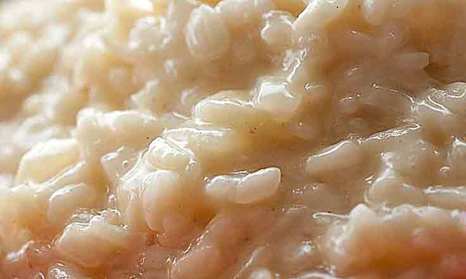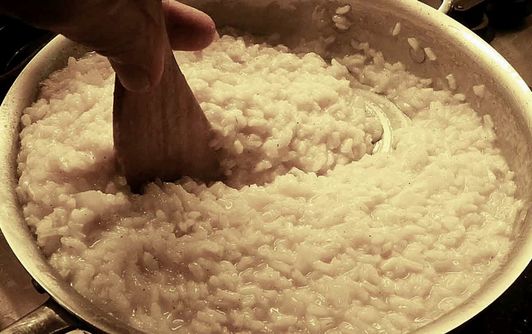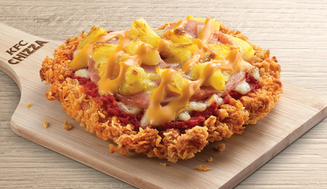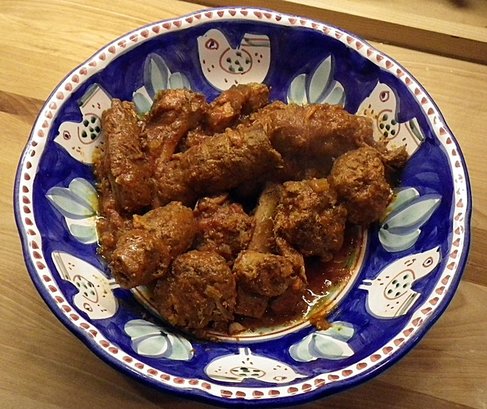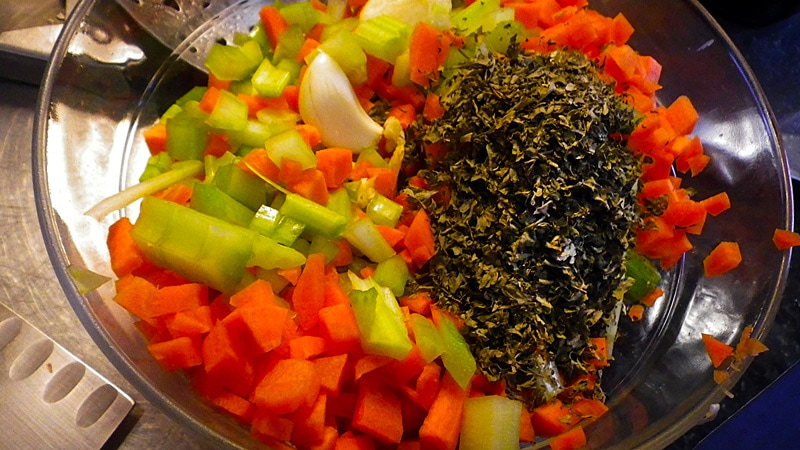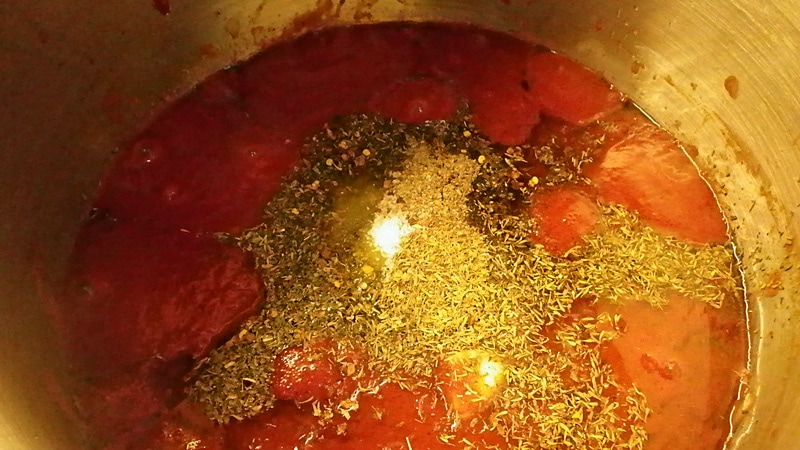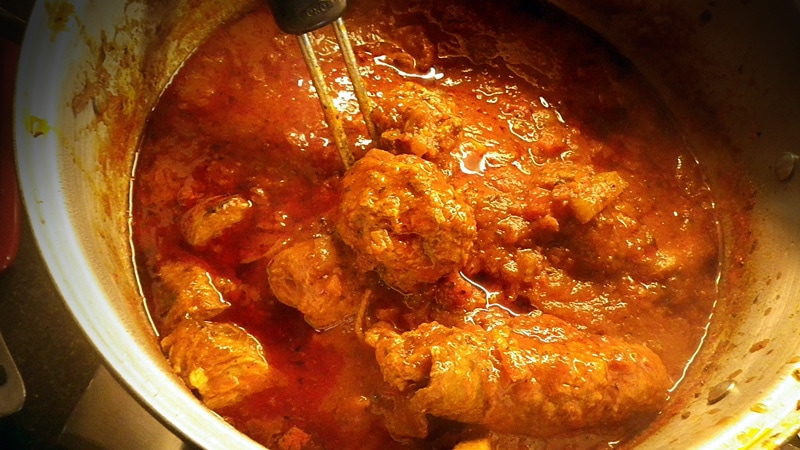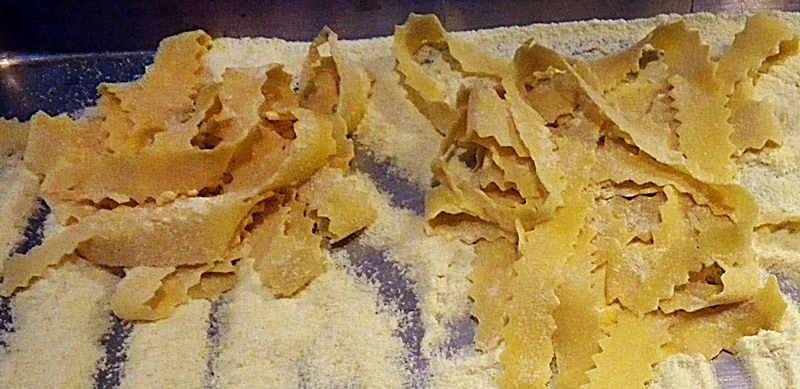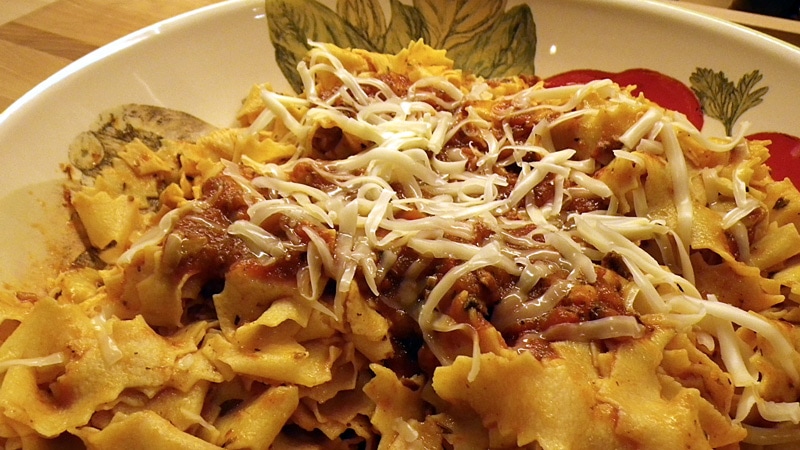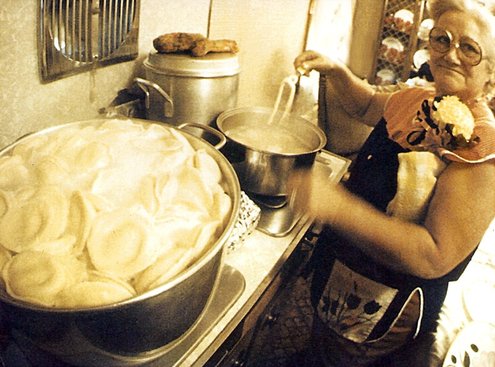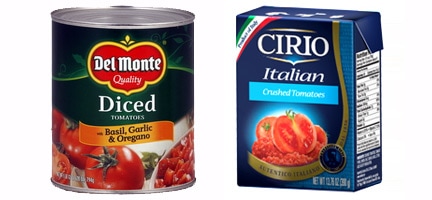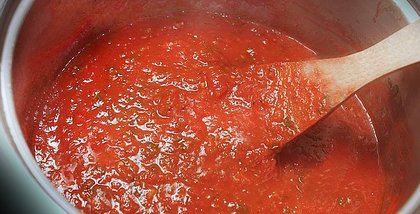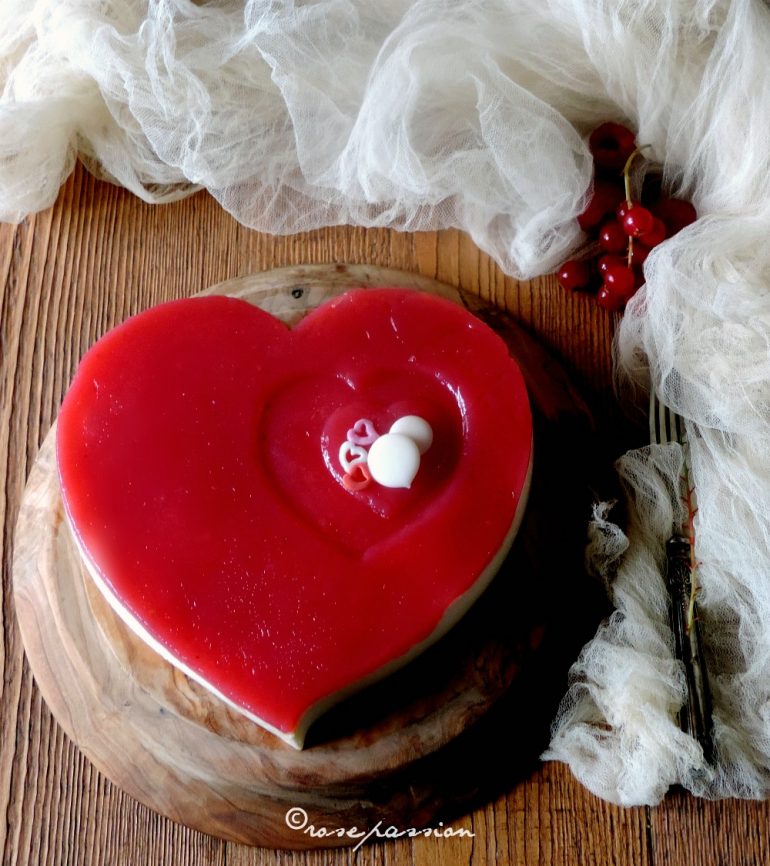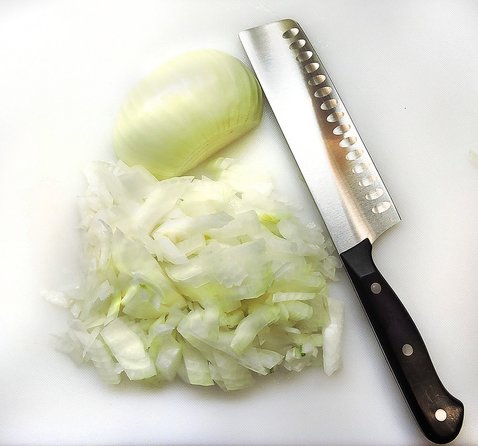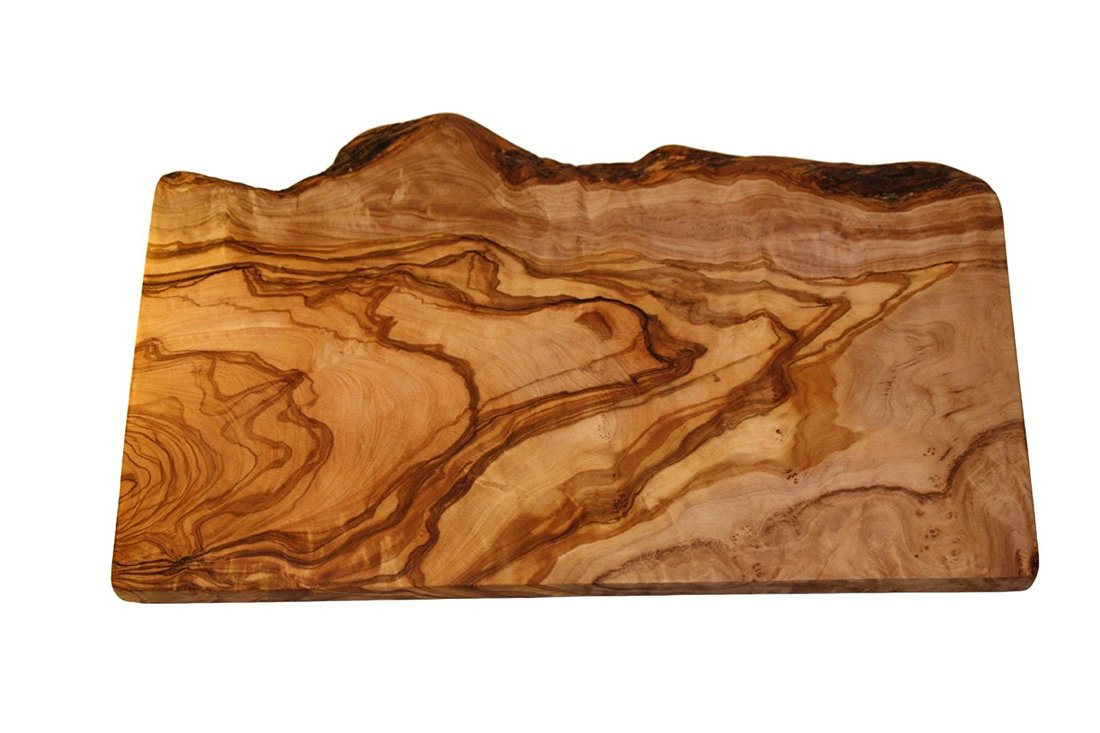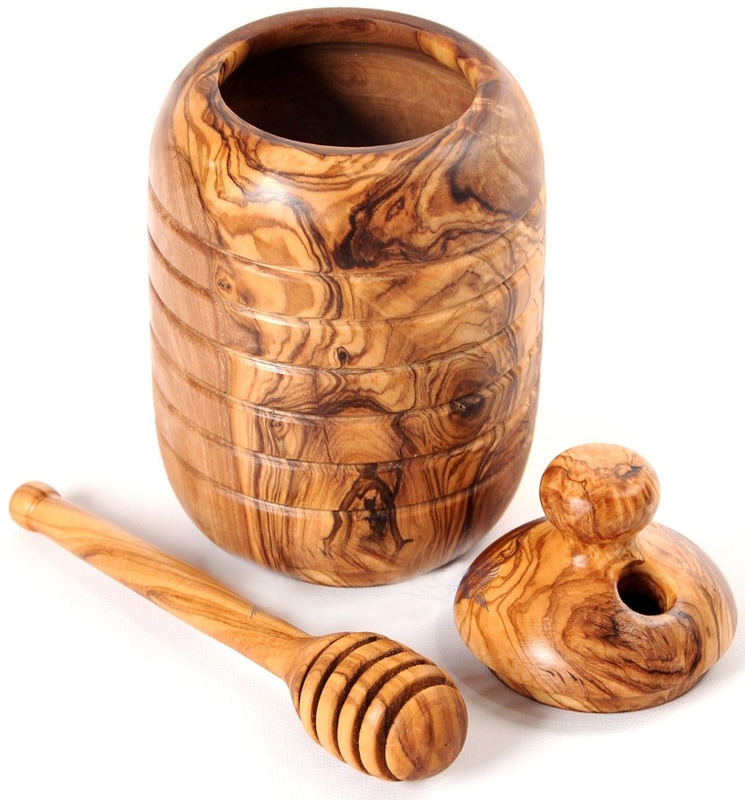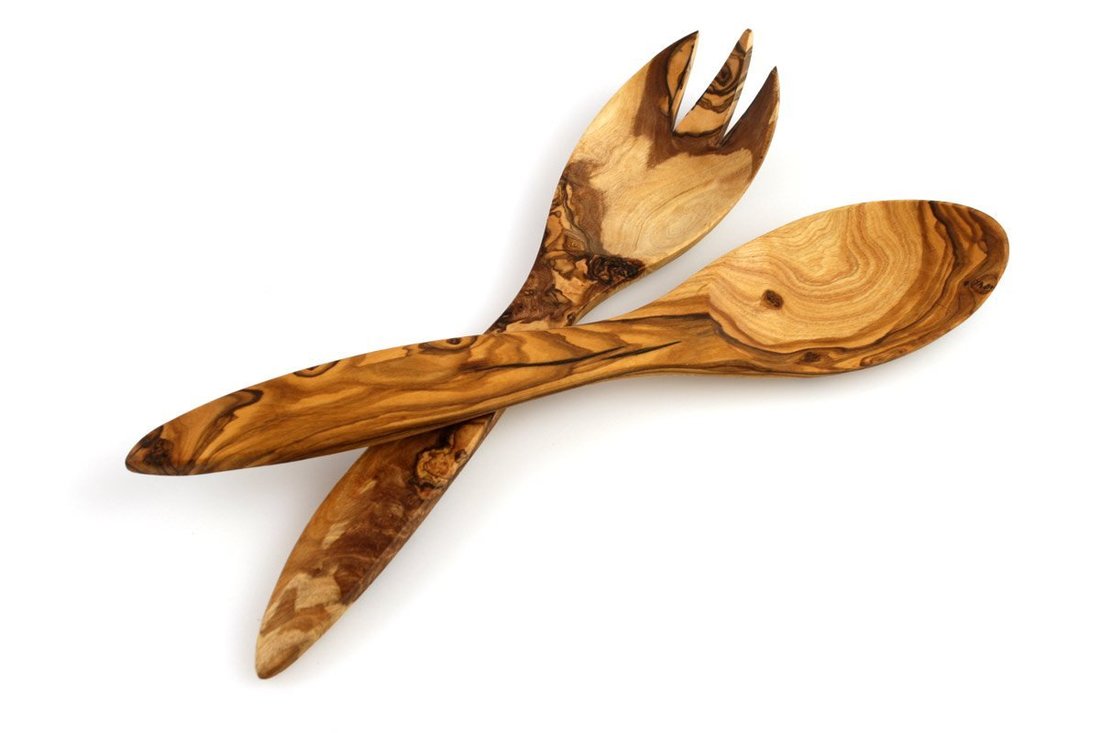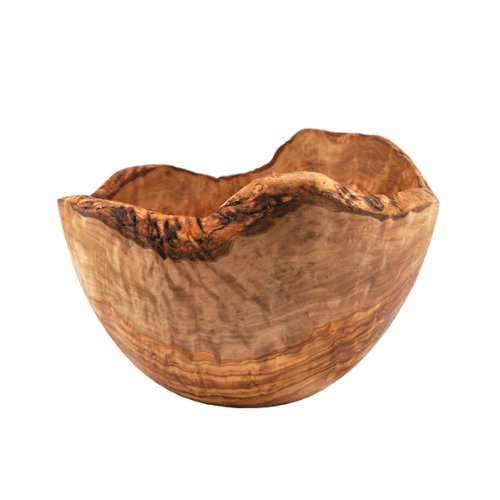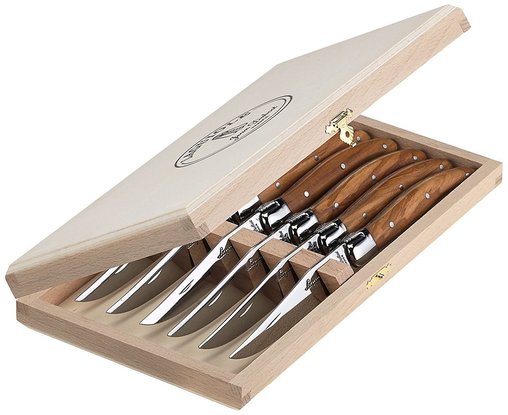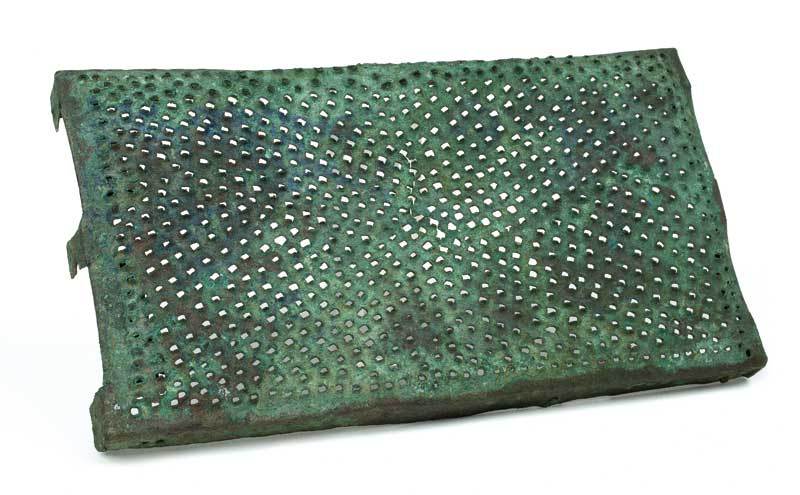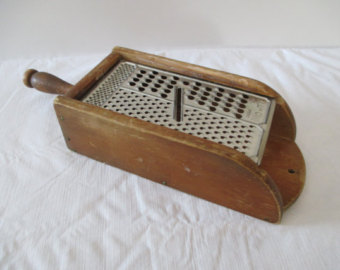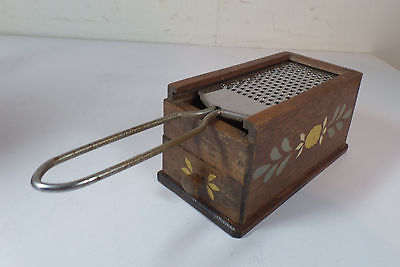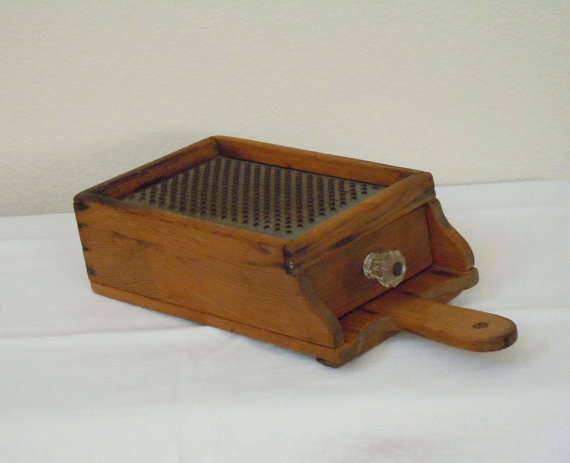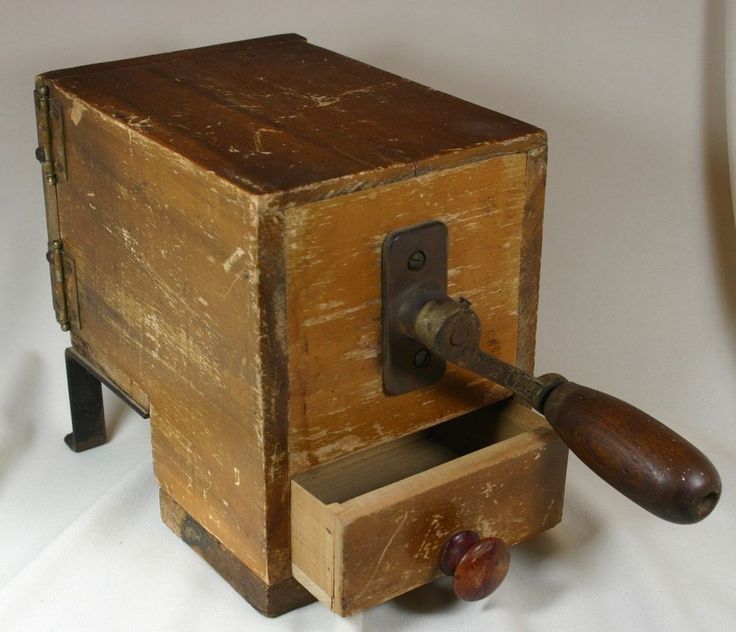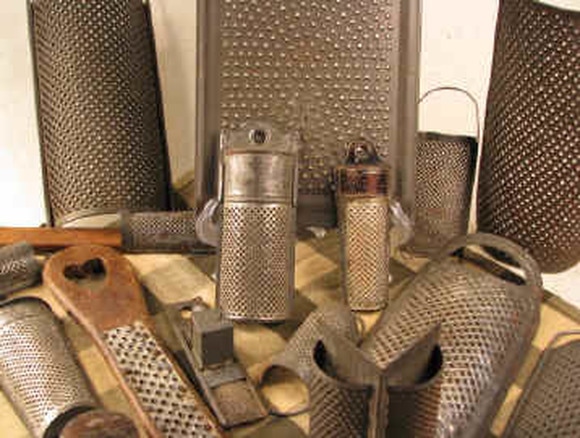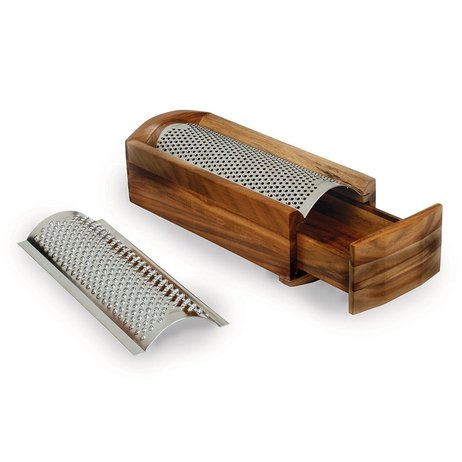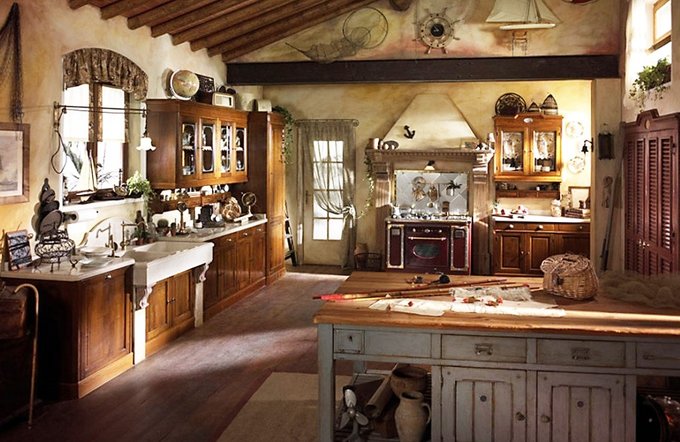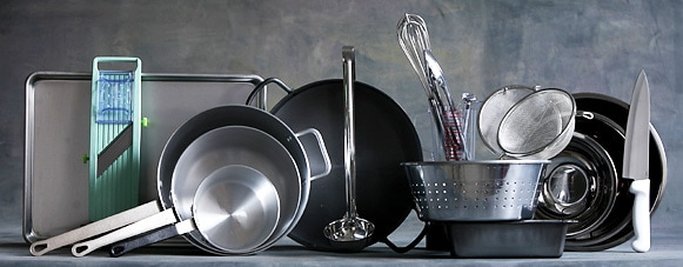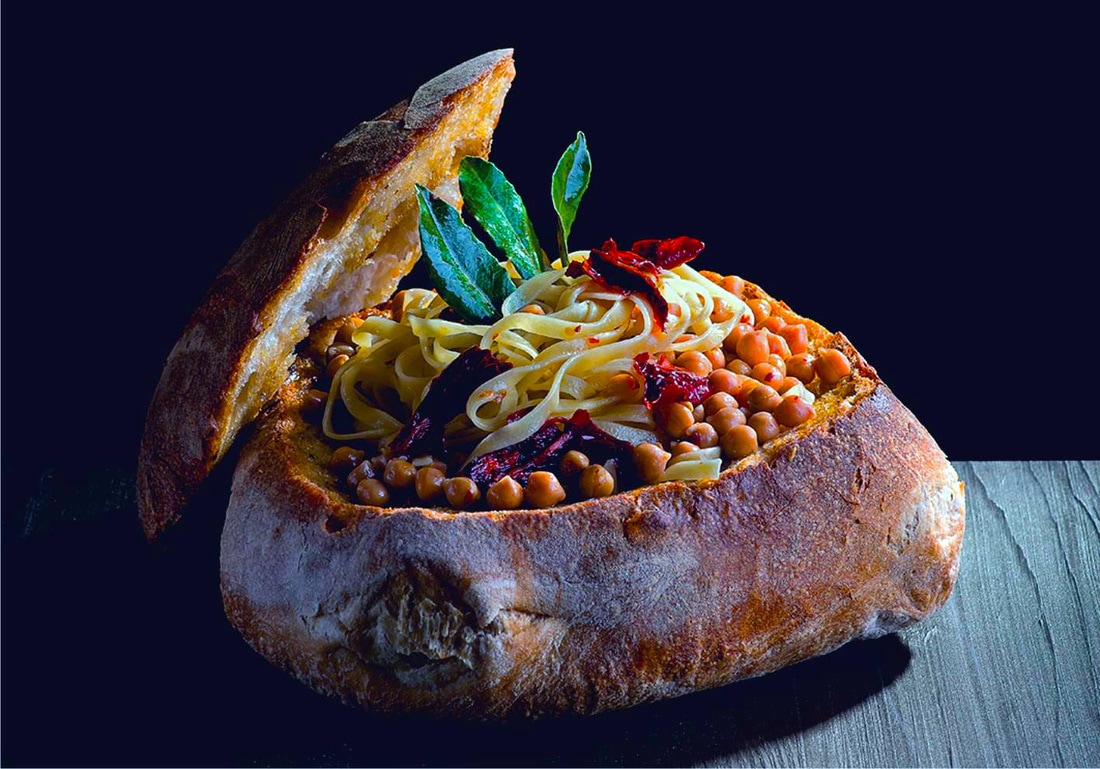 Lucas enjoying risotto in Fiesole, near Florence Lucas enjoying risotto in Fiesole, near Florence The history of Risotto more than likely parallels the influence of the Arabs, who introduced rice to Italy and Spain during the Middle Ages. The high humidity in the Mediterranean basin suited the growing of shorter grain rices, with a booming rice industry having its roots in the north from Genoa and Venice. These types of rice varieties became the basis for both paella in Spain and risotto on the Italian peninsula. Risotto, when prepared correctly, is a simple dish with complex flavors built up during a specific, slow cooking of the rice and ingredients. In its simplest form, the ingredients are arborio or carnaroli rice (the most popular types), butter (or olive oil), onions (or shallots), grated Parmigiano Reggiano and white wine. There are literally hundreds of other ingredients and variations that encompass the world of risotto, with varied spices (saffron being a favorite) and proteins complimenting the dish. The method of slow cooking and stirring tends to gelatinize while being stirred, which helps give risotto it's memorable creamy texture. There are also other rice types well-suited for making risotto: Baldo, Maratelli , Rosa Marchetti , Sant'Andrea and Vialone. The basic technique is to first roast the rice in a bit of fat until it looks translucent, adding wine to deglaze, then adding preheated broth a little at a time while stirring constantly throughout the cooking. Other ingredients, such as Parmigiano Reggiano, and butter are added at the end. Patience is key in making a great risotto at home. The rice needs to feel creamy on the tongue (never mushy) while still being a bit al dente. I could take an hour or more to nurse the risotto into full fruition. There are some tricks for making risotto faster, as restaurant kitchens do, but I won't get into that here. Making risotto at home is an act of love... 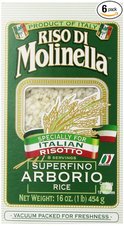 Ingredients 2 cups arborio or carnaroli rice (Click the photo, the see on Amazon) 2 tablespoons light olive oil 1 medium sweet onion (or half a large Vidalia)-diced finely 1 cup dry white wine (Frascati or Pinot Grigio, or one of your choice) 6 cups of chick or vegetable broth, heated in a saucepan (for ladling into the rice) 1/4 teaspoon salt 1/2 stick unsalted butter 1-1/4 cups of finely grated Parmigiano-Reggiano cheese (plus additional for topping off the dish)
Toward the end, you will notice the starch in the rice being released to make a creamy consistency. Occasionally, taste the rice to make sure it is cooked through while still having a little bit of "tooth". You do not want it mushy, but you don't want crunch on individual grains. You will also know when the rice is nearing completion when you experience a sort of "wave" when you stir the rice, making a circular motion with the flat edge of your spoon around the bottom of the pan. Italian chef's call this the all'onda (wavy) effect. When your spoon passes through the rice, and it leaves behind a silky wave that slowly fills in the wake of your spoon, the risotto is at the right texture.
This is an all around recipe that can be varied and added to as you like. I'd suggest practicing this recipe a few times until you consider yourself an expert at making it. After that you can experiment or try your own variations of other recipes you find online. Try a seafood variation by adding shrimp, fish stock and lemon. Or... Roast pumpkin and asparagus (folded in at the end); tomato, basil and pignoli; smoked chicken and eggplant; or classic Milanese style with saffron and peas. Boun appetito! --Jerry Finzi (If you liked this recipe, please SHARE with your friends... grazie). Every year, as usual, I'm repulsed by the new offerings from these so-called chain pizza factories. This year, they didn't disappoint... or rather, they did. Two were so disgusting and revolting that I just couldn't make up my mind which was worst, resulting in the first tie ever. The winners are: Kentucky Fried Chicken's "Chizza" and Pizza Hut's Grilled Cheese Stuffed Crust Pizza In the case of KFC's 688 calorie Chizza, there is no crust. No, it's not gluten-free. The "crust" is actually an encrusted, deep-fried butterflied double breast of chicken topped by a thick acidic tomato sauce, a phony, grated mozzarella cheese, chunks of rubbery, factory-frozen ham, and chunks of canned pineapple that were picked fresh, Lord-knows how long ago. Oh, to make matters (ugh) worse, they top it off with and KFC’s "special cheese sauce". More than likely "special" as in "this special needs some actual cheese". It comes in a diminutive imitation personal pizza box. Cute, no? Ok... no. Oh, and it doesn't come cut in slices like a pizza. It's a bit too small to cut up. You just sort of pick up the chicken "crust" (wash your hands first--and after) and dig in with your choppers. They apparently must have done a lot of committee work and focus groups to come up with their slogan for this mash-up... "All Chicken, No Crust". It's a bit of misnomer since the crust in ON the chicken. The pièce de résistance is that for an extra couple of bucks, you can get an even bigger meal called the Chizza Box, which comes with one Chizza, one deep fried chicken drumstick (if you're in a really ravenous chicken mood), a cup of whipped potato flakes, and just to balance out the "meal"--and just what you'd expect from this gourmand brand--more potatoes in the form of some deep fried "Potato Winders". Of course, a Coke is included in the price, just to help all this go down easily. This got a 9.75 on my Disgust Rating Scale. Pizza Hut's Grilled Cheese Stuffed Crust Pizza is 3200 calories of fake-cheesy, pure evil (that's for a "plain" pizza). Their stuffed crusts have always sickened me before, but this one made me ask, "Who cut the cheese... and why would he do that anyway?"
In addition to the crust being generously stuffed with "cheddar cheese" filling (Cough, "Crap Cheese"), to give it that crumby, grilled cheese mouth-feel, they sprinkle on some garlic flavored, fried buttered-breadcrumbs onto the crust area, and add "garlic-butter sauce" on top of the center of the pizza (I use this term very loosely here). There is often so much breadcrumbs on it, you feel like you're eating breaded... er... bread. The crust winds up tasting more like a fast food, cheesy garlic bread than an All-American grilled cheese, but much, much saltier. This also rated a 9.75 on my scientifically designed Disgust Rating Scale. All in all, these types of offerings make me cringe. Please don't think they are pizza. Your neighborhood pizzeria more than likely can make pizzas that will always surpass fast food, factory "pizzas". besides, real pizzas--whether home made or from a pizzeria--are a lot healthier and tastier than these award winners will ever be. If you want the best pizza, try making them in your own kitchen. (Click HERE to read my three-part series on Making a Great Pizza at Home) --Jerry Finzi 4/7/2015 Nearly every Sunday of my early childhood my Mom made something most Italian-Americans (especially those from Naples) called Sunday Gravy. Simply put, Sunday Gravy is essentially a large batch of tomato sauce with various types of meat slow cooked into it. In Italian, the word salsa means sauce... a sauce is made from something other than meat. Like putting a fruit or cheese sauce over meat, chicken or fish. The Italian word sugo means gravy. A gravy is made from the liquids and fat that are rendered from various meats--like using turkey drippings to make a gravy. The all-day cooking of meat in tomato sauce gives off a heady scent, that would fill our apartment, and waft out into the hallway for the entire building to smell--"Ahh... the Finzis are making Gravy today!" The secret of Sugo is in its slow cooking, or pippiare (literally, to bubble) technique. Sunday Gravy has it's origins from a beef stew popular in medieval XII-XIV century, way before tomatoes were introduced from the New World--a clay cooker slow cooked the stew of beef and vegetables for hours and hours. This beef stew turned into a ragù, at first created in northern Italy, with the southern Neapolitans evolving the dish further by the eighteenth century. It began as a a dish for nobility, using more expensive cuts of meat, such as beef and veal, but no tomato. (Tomatoes didn't gain popularity right away in Europe... they were thought to be poisonous). This dish was mainly prepared on Sundays, the sauce placed on top of the pasta, with larger cuts of meat served as a second course. One historian described a Sugo using tomatoes in 1857 that was being served in taverns in Naples. You can think of Sunday Gravy is a hybrid of sorts... it starts out as a tomato sauce and becomes a gravy after meats have been added and have rendered their flavors during a long cooking period--the Sunday Gravy of my childhood. 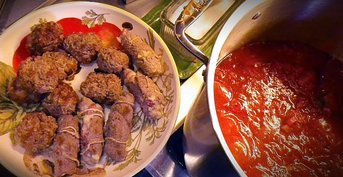 Some of the meat ready to be added to the Gravy Some of the meat ready to be added to the Gravy But Sunday Gravy wasn't just about a making a single meal in la nostra casa. It was an event--a gathering. Making Sunday Gravy is reminiscent of an entire village doing their weekly communal cooking... coming together to make pasta, make bread, make the olive oil, tend the olive trees, fix a roof, gossip, laugh and be together. In Italian communities, ovens were often communal, but ingredients were also communal in many respects--Giuseppe just slaughtered a large pig and barters off some of the meat with Mario, the baker for bread, or perhaps his cousin Maria still has some tomatoes hanging that she would swap, and Marcello's owes him some olive oil to offset the wine that was traded last spring for some pasta. Food was communal. Food was family. And good food takes time and preparation and lasts for more than a single meal... My Mom started making Sunday Gravy sometimes on Saturday... or even in the middle of the week before. Being a working Mom and was frugal with her time. She would make a meat dish one night--maybe the meatballs. Then she'd give us a simple dinner with some of them, but hold most of them for adding to the Sunday Gravy pot. Maybe on Saturday after shopping, she'd make the brasciole and brown the pork ribs under the broiler. These would also go into the fridge, ready for the Sunday Gravy pot. Sunday morning would arrive and I'd go to Mass with one of my sisters and then stop at a bakery to pick up "buns" for our whole family--even my Aunt Rose's family who lived upstairs. In our family's jargon, "Buns" were anything sweet from the bakery... cream donuts dusted with cinnamon, raisin "buns" (my favorite), a crumb cake with crumbs as big as my 5 year old fist, a cheese danish that would fill a plate, and maybe a dozen "mixed buns"... assorted goodies that the person behind the counter would surprise us with
Sunday Gravy wasn't just about the one meal. It was also about what we'd be eating in the coming week--there would be lots of leftovers in that big pot. The gravy might even allow us to cheat a little on "meatless Friday" by using just the tomato sauce without any meat on pasta, ravioli or with fish. And everyone knows that Gravy tastes even better over the next few days. The flavors of all those meats meld into the sauce turning it magically into a true gravy--rendered from meat. It's a carnivore's manna--nectar straight from our Roman and Greek bloodlines. My Dad's very large family ate from a single pot.... and a single bowl in the middle of the table. You can imagine the Sunday Gravy there with brothers and sisters taking a meatball here, a rib there... a couple of these meats, a piece of bread or pasta and some of this gravy and you had an incredible meal. Filling, nutritious and delicious. A necessary thing when our Nonna's had so many mouths to feed with so little.  Mariantonia Delulia, my Grandma Mariantonia Delulia, my Grandma In our famiglia, there were lots of mouths to feed--seven of us in our family, and the dog. My cousins and Aunt would stop by, too. Then there were my sisters' girl friends and my brother's crew. There were always extra plates for whoever stopped by. It was about the famiglia... the heritage... the food... the tastes that even our memories had forgotten and unknowingly were our a link to our past.... Naples, Molfetta... and my maternal Grandmother, Mariantonia Delulia. (Once I learned her real name I was compelled to say her full name over and over... like poetry off an Italian tongue... "Maree - ahn-TONE-eaa-ahh Day-LULE-eeah". ) This wonderful lady towered over me (as a small child) at 4' 10", with her greyed hair tucked into a bun in the daytime, but releasing nearly three feet of it down her back at night before bed. Grandma made her own version of Gravy... everyone does it slightly differently. She'd add large strips of peppers and larger chunks of onions, and put pignoli in her meatballs. A cut up pork shoulder (the affordable cut for poor immigrants, when they could afford it) was key to her recipe, along with hot sausage (way too spicy for my young tongue back then). Before we would get through the comics, our little railroad apartment would start to smell differently.... sweet, pungent... Italian. Mom would start by taking a huge onion and cutting it up into small pieces... and sautéing them in the bottom of her huge stock pot on the kitchen stove until they were soft and glistening and letting off their pungent scent. Then she would add the diced carrots, celery and garlic. After that, my Dad would get the wine from the cellar (he'd sometimes have jugs of some home made wine he got from my Uncle down there) and pour some into the pot. Not sure how much.... maybe a couple of cups. Next, Mom would let one of us open the cans--big cans of imported tomato puree. It was fun opening cans using the wall-hung can opener over by the dumb waiter door (nailed shut by Dad so us kids wouldn't try to go for a ride.) About four or five cans would go into the pot. Next came the spices. A handful of sugar to cut the acidity, half-handful each of dried basil, oregano, thyme, garlic powder (or a 5-6 cloves of fresh when Mom had it), a good sprinkle of red pepper flakes, a tablespoon each of salt and pepper, then a quarter cup of olive oil. If Mom had any leftover rinds of cheese from a grating wedge, they'd go in too. Then she'd take out the meat... lots of it. A rack of ribs cut up would be layered in like logs at the bottom of a red lake. Then would come the sausage browned and cut up into 2 inch pieces, then add the brasciole--all tied up like meaty little packages, and then the meatballs. Then the Sunday Gravy pot is put on the back burner--the smallest one--and starts to simmer and simmer, bubbling like a crater of lava from the old world. The aromas get more and more intense as the day goes on--you can taste the flavors turning the tomato sauce into something... luscious. My siblings' friends come and go with an open door policy, my mother always inviting them to have a "bun" or sit down for a meatball sandwich. There was more than enough... a few would never be missed. As for us, we would taste the Gravy all day long by getting a piece of bread and spooning some on top. What a treat. I still do this when I make gravy--or sauce. Taste it on top of a piece of bread... fine tune the spices, then simmer some more. Lucas is growing to love this little snack way before dinnertime. In the Fifties we would sometimes eat Sunday "dinner" at 2 in the afternoon if my Mom was lucky enough to get the Sunday Gravy in the pot early enough. Otherwise, we'd eat by 5 or so. There was no set dinner time on Sundays in our house. Besides, we had "buns" in our bellies--the starch, fat and sugars keeping our fluttering young hearts going. No one went hungry on Sundays. 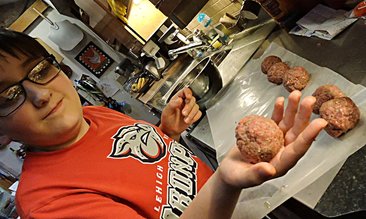 Shaping meatballs Shaping meatballs The New Famiglia Finzi "Gravy" This past Easter I made Sunday Gravy, as I described above. I didn't follow a recipe... I followed my memories. Perhaps this is why I didn't write this article as I would a normal recipe. I don't want people to simple follow the recipe in any strict way. This a recipe that needs to be felt. Vary it with love--the things you love, and share it with people you love. Make meals out of its components both before, during--and after--making it. We've already had two meals from it. It all came together for Easter Sunday's late afternoon meal, as my family had done time and time again so many years ago. We'll probably freeze half of it for future meals. We made home made tagliatelle to have with it the first night and a risotto for another meal on another day. But we also had each other. We shared garlic bread and wine with it--Lucas had a little glass too. I'm teaching Lucas how to drink with a meal rather than drink to get drunk. He places a small forkful of meat in his mouth, chews a bit, sips some wine and discovers the flavors as they mingle and merge into something Godlike.  Making the tagliatelle Making the tagliatelle Making Sunday Gravy was like having a family Mass with a prayer beforehand, and more afterwards. It's a joy to watch my boy Lucas' eyes light up as he discovers great flavors. Lisa helped me with some parts of the meat preparations as early as Thursday. Lucas helped make the meatballs and the pasta. Lucas is also a spice expert (great palette on that kid), so I told him to, "Make an Italian tasting spice rub for the ribs". He nailed it. Mom made the risotto we had for our second meal (her first time making risotto... usually I do all the stirring). The Gravy mixing with the rice turning it into something dreamy. Traditions--or perhaps I should say rituals-- are important in our family, and in our food. After all, the food holds ties to our heritage and the food eventually becomes us. Literally and spiritually.
Happy Easter. And thanks, Mom for all those tasteful Sundays. --Jerry Finzi 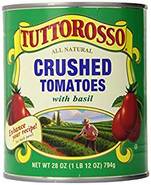 Ok, here's my basic pizza sauce. On lazy nights when I'm in a hurry, sure, I'll use a bit of jar sauce (I like Bertolli Tomato & Basil, real basic), Whatever you do, don't use any of the jarred sauces called "pizza sauce". Any that I've tried have been absolutely terrible. Trust me, there's nothing like making your own pizza sauce. To start with, there are two brands of crushed or diced tomatoes that you can use as a starting point. Del Monte Diced Tomatoes with Basil, Oregano and Garlic is a decent one. It has finely diced tomatoes of decent quality and taste. There isn't much sweetness so I tend to add a bit of sugar to cut the acidity. Cirio Crushed Tomatoes is a recent favorite for when I'm looking for a more Italian taste... it has a higher sugar content, so I don't add sugar when I use Cirio. The box is a bit awkward to open... be careful. But lately, my all time favorite to use for pizza sauce (and sauce recipes) is Tuttorosso Natural Crushed Tomatoes with Basil (a six pack of 28 ounce cans on Amazon, $19) . The "crushed" is so extreme that it makes the sauce in the can thick. I will always add a half cup of water or so to thin it out a bit when making pizza sauce. The flavor that this brand gives to the sauce is amazing. Ingredients 1 - 16 ounce can/box of crushed or diced tomatoes 2 tablespoons of dried basil pinch of salt 1 tablespoon sugar (unless using Cirio brand) 2 tablespoons extra virgin olive oil optional, 1/2 teaspoon of chopped/ground red pepper flakes (if you like heat) optional, 3 cloves garlic, finely sliced (or a tablespoon of Bellino Minced Garlic) optional, 1 small diced onion, sauteed in olive oil first Place all the ingredients in a saucepan and heat for 5-10 minutes, then use an immersion blender to smooth our the texture. If when using the Cirio crushed tomatoes the sauce looks a bit thick, add a bit of water (2-3 tablespoons) and blend again. When I use the Tuttorosso, there is no need for the immersion blender but I always add about 1/2 cup water. If you like a chunkier sauce, use the Del Monte diced tomatoes in your recipe but don't blend it. For a fresher flavor, combine all the ingredients and don't heat it. Simply blend to a smooth liquid and use this directly on your pizza. Heating the sauce combines the flavors cohesively while using a cold sauce on pizza gives a brighter, fresher flavor. Try it both ways and see what you think. In summer, you can simply use tomatoes off the vine to make a sauce. Drop the whole tomatoes (San Marzano plum or any paste tomato varieties types are great) into a pot of boiling water for a few seconds, then transfer immediately into an ice water bath. This loosens the skin. Remove from the ice water then using your hands, slip the skins off. Crush them in your hands then use in the recipe preparation above.
I use a small ladle to spread the sauce on my pizza, just remember... don't use too much sauce. (Store any unused sauce in an airtight container for up to 2 weeks). There are some pizzas (like a basic pizza Margherita) that are much better with a splash of sauce here and there with some of the dough showing through. And experiment: while most put the sauce on the dough first, other types of pizzas call for the cheese underneath the sauce. Your choice. Buon appetito! --Jerry Finzi If you enjoyed this post, please SHARE it with your friends. Grazie mille! Panna Cotta with Raspberries and Red Currants
A recipe from Rose Passion... Panna cotta is a dessert from Piedmont--a classic of Italian cuisine. Versatile and simple to make, it realize lends itself to numerous interpretations based on tastes of the seasons. In this dessert, the creaminess is enhanced by the tangy flavors of red berries. Instead of classical coulis, I chose a delicious combination, and particularly a water-based cream with raspberries and currants which gives a sour hint in contrast to the sweet cream. The originality of this recipe is in the range of healthy ingredients as well as in the final presentation. I used a wonderful heart shaped pan for this panna cotta--an elegant and romantic look perfect for Valentine's Day. To purchase in Italy, click " Heart ". (GVI: Or you can use one like this on Amazon). Ingredients: 400 g fresh cream 100 g milk 2 g agar agar 80g caster sugar For the cream to water raspberries and currants: 150 g red fruits (raspberries and red currants) 250 ml water 120 g caster sugar 50 g cornstarch 1 g agar agar Procedure: Blend the red fruits and strain the sauce through a sieve to eliminate the seeds. In a cold saucepan stir: sift together the starch, sugar, water and agar agar. Add the raspberry sauce and currants, stir and bring to a boil. The cream will take on a gelatinous appearance. Remove from the heat and quickly pour the cream into the silicone mold. Level the surface and let solidify in the refrigerator at least 2 hours. Prepare the panna cotta: in a cold saucepan, melt the agar agar in milk, stir and add the cream and sugar. Place over medium-low heat and simmer for about 3 minutes. Pour the mixture into a bowl and stir occasionally to prevent a skin from forming. Once the panna cotta is cold, pour over the raspberry cream and currants. Let stand in the refrigerator for 4-6 hours. Turn out and serve the panna cotta on a serving dish. Notes: For a lighter version, replace the cream with coconut milk; Use soy milk or almond instead of whole milk. The cream is a water-based gluten-free--ideal for filling and decorating desserts. Versatile and lightweight, you can make it taste like pudding by adding 25 g of butter. I omitted the red dye and added agar agar. Click HERE For more on the wonderful Rose Passion blog. I've learned things in my many years of cooking... and I'm still learning lots of tricks and shortcuts in nella cucina. From time to time, I'll be passing long these Kitchen Hacks you our fellow Voyagers to help with many cooking tasks... As you can tell, the first Hack concerns onions. There is a real science behind this Hack. Perhaps too much for the home cook to even want to understand. To boil it down: when you cut an onion, it releases sulfenic acid which then changes into other compounds as soon as they make contact with the air. These are the chemicals that burn your eyes so much. Some people think it's the variety of onion that makes a difference, but the more precise truth is that it's where the onion is grown and in what type of soil that matters most. Sweet onions grown in less sulfur rich clay soils in places like Georgia contain less sulfur to start with. All you really have to remember is to buy only "Sweet Onions" (this is what they are called in the U.S.). You will find them called Vidalia, Maiu Sweet, Mayan Sweet, Walla Walla, etc. Do NOT use the bagged, smaller sized "yellow" onions. These are storage onions, and as such, their level of sulfur compounds increase as they age and when cut, they really burn your eyes. Sweet Onions (we buy Vidalia unless making something requiring large amounts of onions, like French onion soup) are typically much larger and often a flatter, less round shape. They are also wetter than "storage" or bagged onions. As onions sit for long periods of time they dry out. The higher water content in large sweet onions help dilute the sulfur compounds. The dryer the onion, the more likely it will make you cry. Here's a ranking with the LESS TEARFUL types on top:
Good luck keeping those tears at bay... --Jerry Finzi As an alternative, try these pro quality chef's onion goggles....
Laguiole Sommelier - Corkscrew  If you're discovering the world of fine Italian (or French, or even domestic) wines, you'll need to learn to open a bottle the way the professional sommeliers do... with a specialized device called a Sommelier. I bought my olive wood handled one in Alberobello, Puglia--the land of the magical Trulli pointed houses. One of the best to own is a Laguiole style... and this is a very good priced one. It has a cutter to slice through the foil covering the cork, a corkscrew and a two-stage lever for extracting the cork. Click the photo or HERE to see this on Amazon for $100.
Mattarello/Rolling Pin My wife Lisa gave me this as a stocking stuffer this past Christmas. It's a beautiful olive wood mattarello--a perfect small size (13") for rolling out pasta dough for hand made lasagna or tagliatelli. Being made from sustainable olive wood resources is a big plus in my book. Click the photo or HERE to see it on Amazon ($37) Authentic, Certified Jean Dubost Steak Laguiole Knives 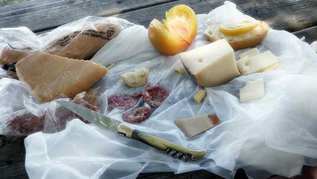 My "Honeymoon" Laguiole on the job My "Honeymoon" Laguiole on the job I have several Laguiole pocket knives. My first (with a fold-out corkscrew) was bought in Paris on my honeymoon, by my own honey as a gift to me. We had many picnics using that knife, both in France and Italy. I keep that one in my pocket every day.  These are beautifully made knives that will last a lifetime. The boxed set of six steak knives pictured above are the original style--and high quality--made in Thiers, France. They are not the poor imitations made in China from inferior steel and plastics that you see in catalogs nowadays. And these all have the little bee on the shank of the blade in fine detail. Compare these to the cheap knockoffs and there's no comparison. The price reflects the quality. And to be clear, there is no such thing as a "Laguiole" brand... it is actually the name referring to the style (shape, design, quality) of knives made in the town of Thiers in the Auvergne region central France. The next time you try making a 4 inch thick, Bistecca alla Fiorentina over an open wood fire, you'll apreciate the feel of these blades. An investment of a lifetime, click the large photo above or HERE to see them on Amazon. ($390) When you think of it, there's nothing as timeless as olive wood. These trees have been around since before the dawn of man. The wood is sweetly scented. The oils are precious to cooks throughout the world. And there are trees in Italy that are monuments to their long lived species. Viva l'olivo... --Jerry Finzi Reminder: Support our site by clicking on the item you are interested in and then placing it in your Amazon Shopping Cart. You'll have 89 days to decide to purchase the item.
We appreciate your support! Ciao, Amici! 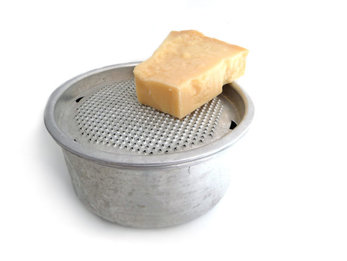 Mom's Grater Mom's Grater Whenever my wife grates Parmigiano Reggiano, she uses the same kind of cheese grater that my Mother used--a round, metal bowl with a dome-shaped grater on top. It only has fine holes--the type that grates the cheese fine enough to fit through the holes on the cap of of our glass cheese shaker jar. Watching Lisa shimmy and and shake as she grates away while I make out Saturday night pizza carries me back in time to our little apartment--Mom grating cheese while one of my sisters fills the "big pot" with water for Sunday's pasta and "Sunday Gravy" (Sugo). The nutty scent of grated cheese foretold of what was to come in the afternoon: meatballs, braciole, pork ribs and sausages. There's something a bit old-world and romantic about grating cheese. Perhaps because it's something that's rarely done in American homes, with plastic tasting jars of phony grated cheese on their tables. As for us, the only jar on our table is filled with cheese we've grated ourselves.... or Lisa, that is... --Jerry Finzi I like this Enrico 1005 Acacia Wood Cheese Grater and Shredder for $53 on AMAZON. Small enough to store easily, attractive enough to leave out on the kitchen counter and with the two most useful cutters included. --JF
Pantry Staples (Graffette di Dispensa) Salt sale Pepper (ground) pepe Oregano origano Basil basilico Coffee Grounds caffè machinato (whole beans are caffè in grani) Tea tè Milk latte Bread pane Chocolate cioccolato Ice Cream gelato Sandwich panino 0r sandwich Cream crema Sugar zucchero Flour farina Cornmeal farina di mais Corn Starch amido di mais Yeast lievito Baking Powder lievito di polvere Rice riso Butter burro Balsamic aceto di balsamico Olive oil olio d'oliva Garlic aglio Chickpeas ceci Beans fagioli Cereal cereale Onion cipolla Tomato pomodoro Canned Tomatoes pelati (canned/jar peeled tomato puree) Bell Pepper peperone Salad insalata Pasta Pasta Cheese formaggio Cream cheese creme di formaggio (Italians call it "Philadelphia") Eggs uova Egg whites albumi Egg yolks tuorli d'uovo bacon bacon, pancetta (raw bacon) pancetta affunicato (smoked), lardo (fatty, spiced) Ham prosciutto (baked or cooked ham) Prosciutto prosciutto crudo (di Parma), or Speck (smoked) Beef manzo Ground beef carne di manzo macinata Pork maiale Chicken pollo Turkey tacchino Sausage salsiccia Wine vino Water acqua (naturale or gassata, without or with carbonation) Bottle bottiglia (ask for a "bottiglia d'aqua gassata") Strawberries fragole Blueberries mirtilli Melon melone Apple mela Peach pesca Pear pera Cherries ciliegie Grapes uva Raisins uva passa Figs fichi Orange arancia Lemon limone Ice ghiaccio Ice Cubes cubetti di ghiaccio Kitchen Tools & Appliances (Utensili da Cucina & Elettrodomestici) Cooktop - la Fornello
Freezer - il Frigorifero Oven - il Forno Gas - Gas Microwave - il Forno a a Microonde Dishwasher - la Lavastoviglie Toaster - il Tostapane Food Processor - il Robot da Cucina Coffee Maker - Caffettiera (for serving or making in) Italian Style Coffee Post - Moka Roasting pan - la Teglia Sauce Pan - la Pentola Frying Pan - la padella per friggere Lid - il Coperchio Kettle - il Bollitore Fork - la Forchetta Spoon - la Cucchiaio Wooden Spoon - il lCucchiaio di Legno Whisk - Frusta Teaspoon - il Cucchiaino Tablespoon - il Cucchiaio di Tavola Thermometer - Termometro Soup Spoon - il Cucchiaio della minestra Ladle - Mestolo Knife - il Coltello Plate - il Piatto Bowl - la Boccia or la Scodella Colander - Colino Strainer - Setaccio da Cucina Box Grater - Grattuggia Cup - Tazza Glass - il Bicchiere (di vino, d'acqua etc.) Serving Platter - il Piatto da Portata Jug or Pitcher - Brocca Measuring Spoon (or cup) - Misurino Rolling Pin - Matterello Table - il Tavolo Chair - la Sedia Cabinet - l'armadietto Kitchen Cupboards - Pensili della Cucina (or Armadi) Wash - Lavare Rinse - Risciacquare Bake - Cuocere al Forno or Cuocere Freeze - Congelare Fry - Friggere Boil - Bollire Steam - Cuocere a Vapore Dice - Dadi (as in Dadi la Cipolla, dice the onion) Chop - Tritare Grill - Cuocere alla Griglia (verb) or Arrostire alla Griglia Broil - Bruciarsi (verb) Roast - Arrostirsi Sink - Lavello Drain - il Tubo di Scarico Sponge - il Spugna Kitchen Towel - il Asciugatutto Faucet - Rubinetto Trash Can - Cestino Aluminum Foil - Foglio di Alluminio Wax Paper - Carta Oleata Parchment Paper - Pergamena Napkin - la Salvietta |
Archives
May 2024
Categories
All
|

